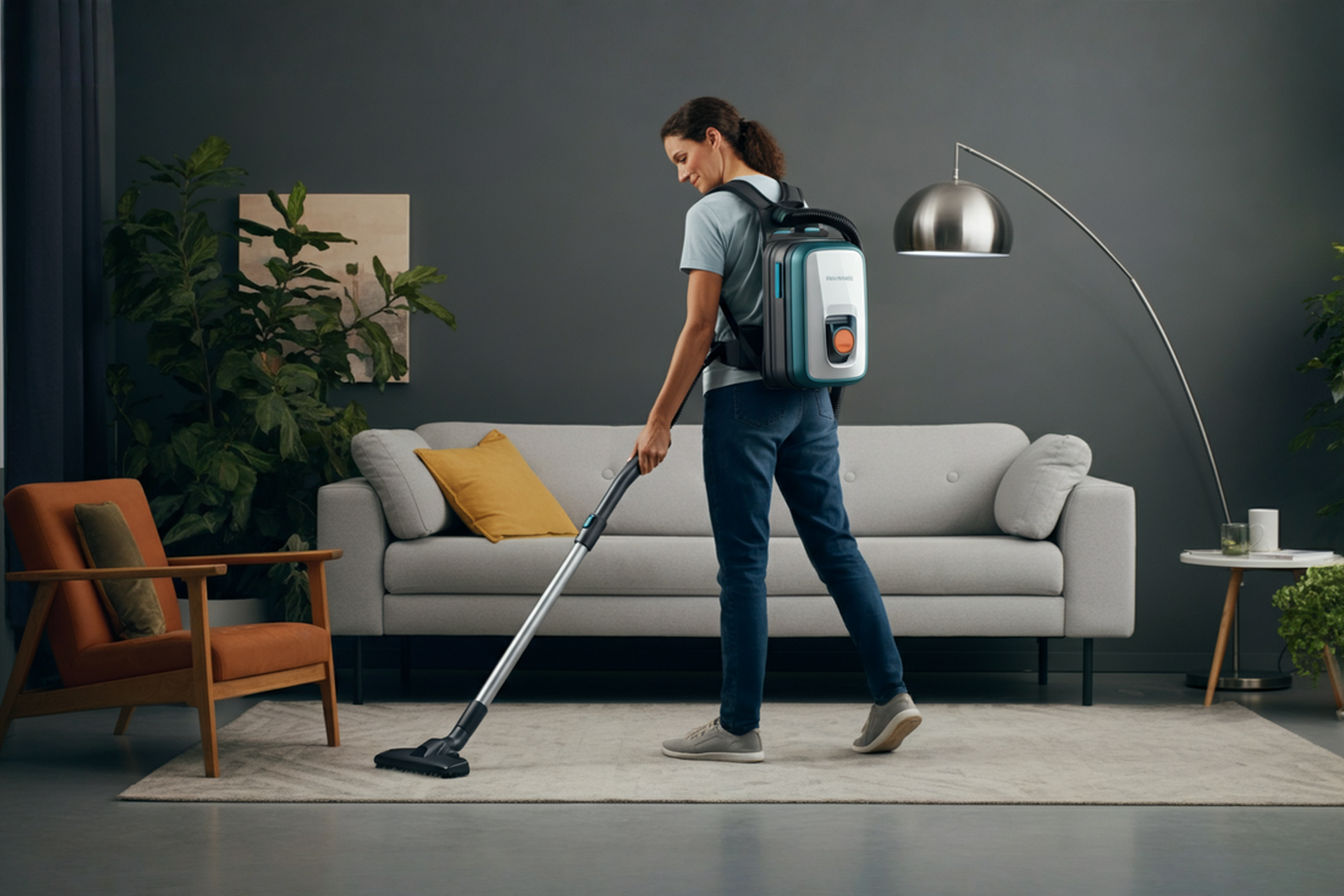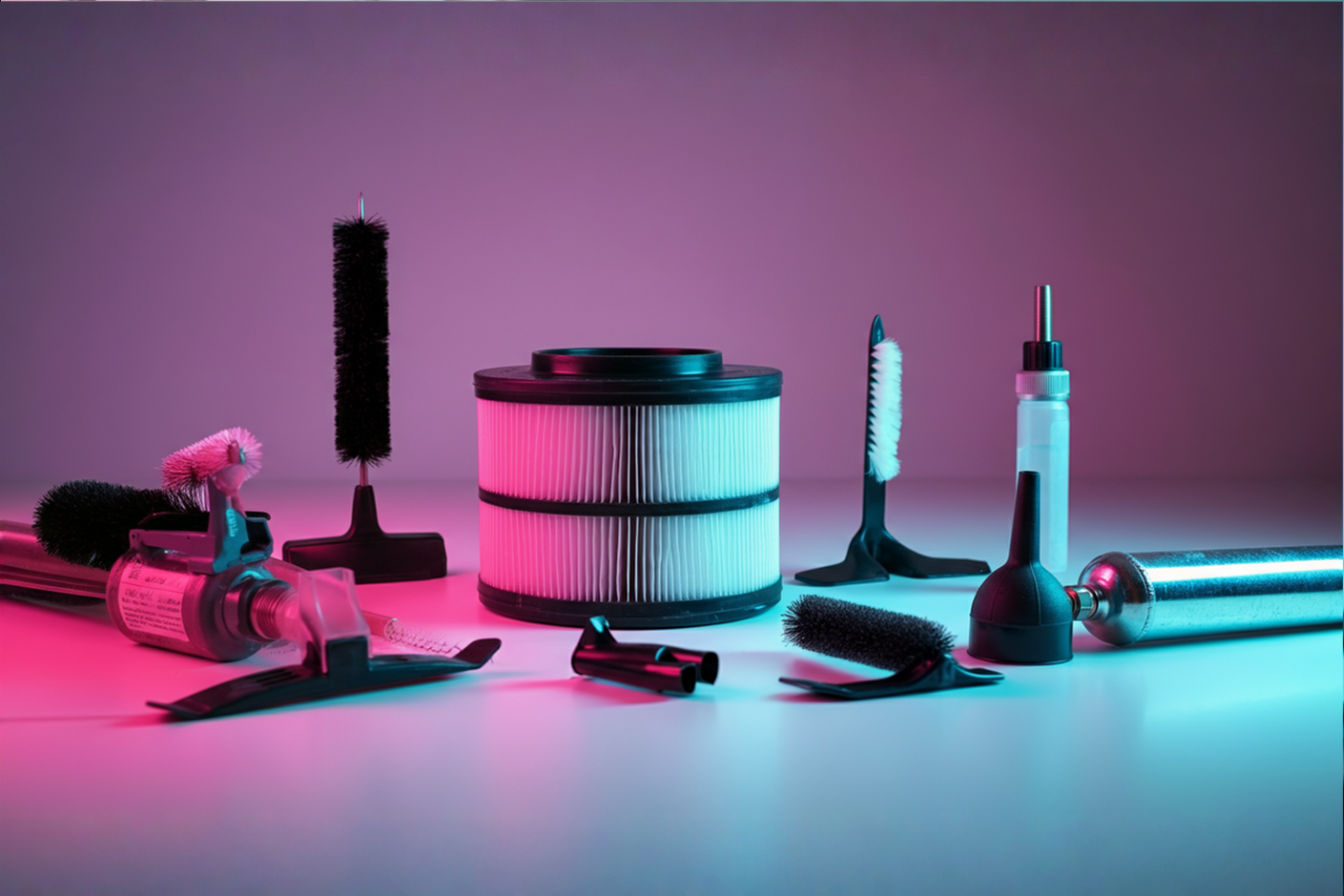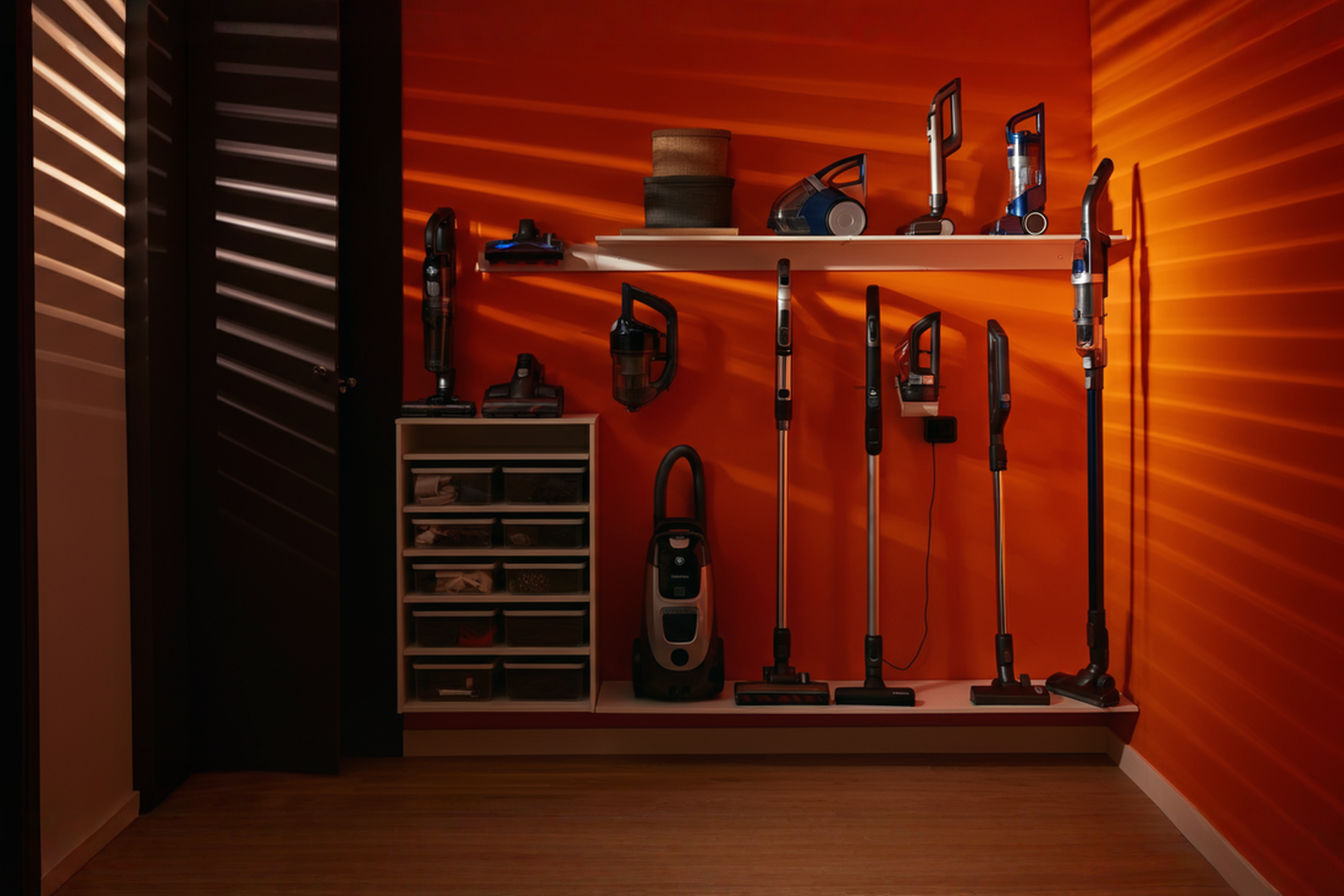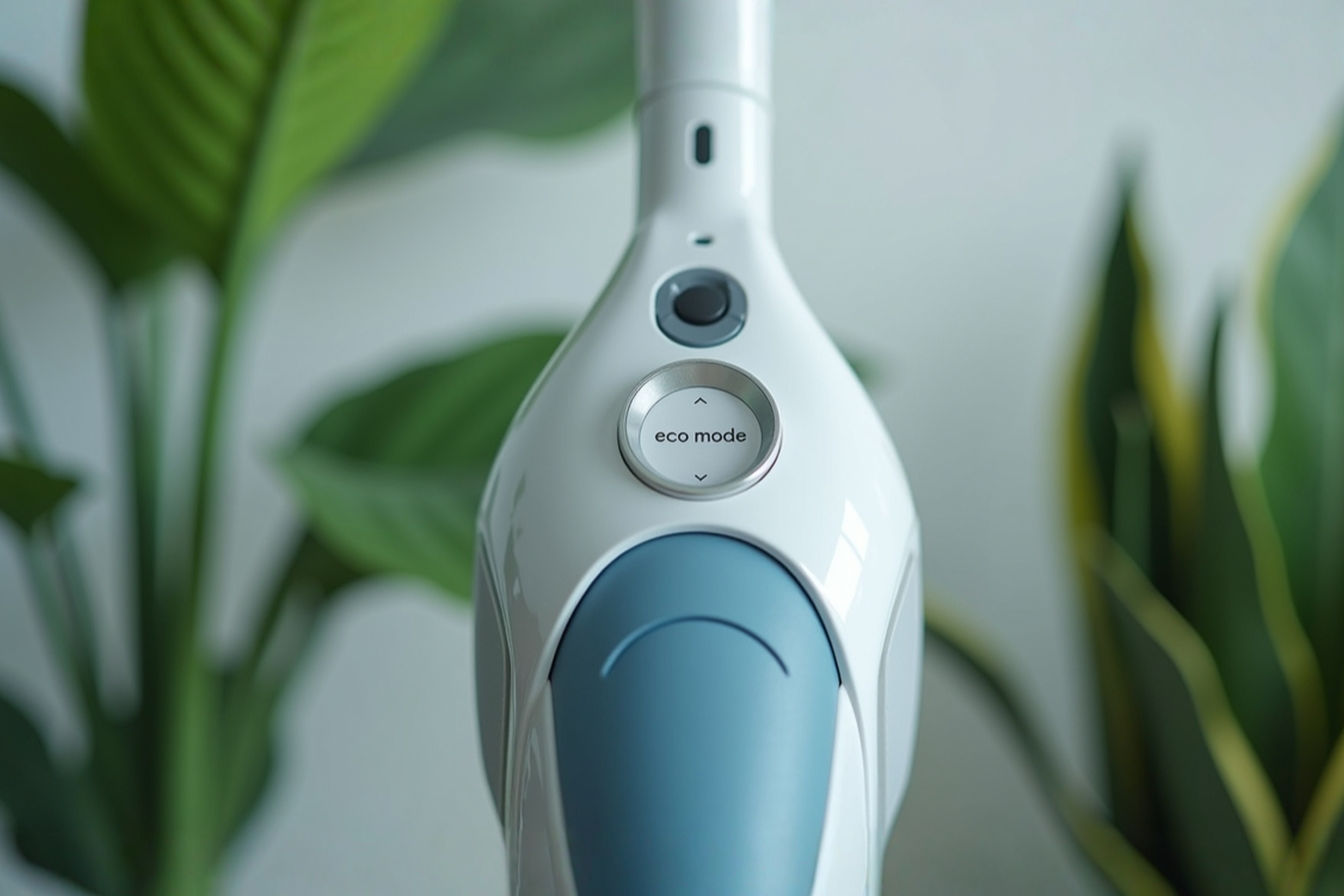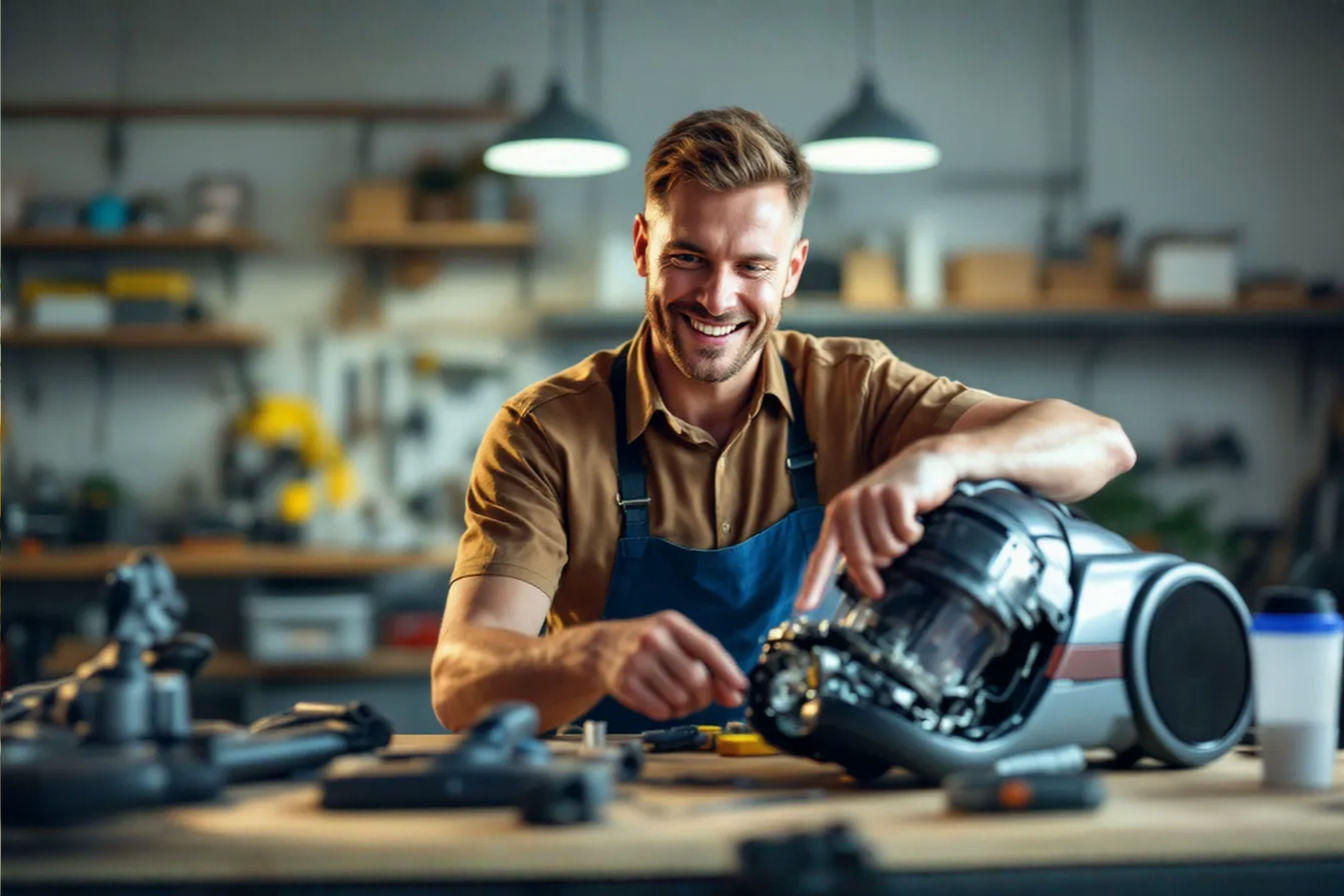Backpack Vacuum Adaptation: Commercial Tools for Residential Efficiency
Learn how adapting commercial backpack vacuums for residential use can save you time, reduce physical strain, and provide superior cleaning performance for your home.
This post may contain affiliate links. If you make a purchase through these links, we may earn a commission at no additional cost to you.
Keeping your home spotless often feels like an endless battle against time and efficiency. You clean one room only to find another needs attention, and traditional vacuum cleaners can make the process cumbersome with their limited mobility and constant plugging and unplugging. What if there was a better way? Commercial cleaning professionals have long embraced backpack vacuums as their secret weapon for efficient cleaning—and now homeowners are discovering the same advantages.
These powerful, wearable cleaning machines offer a revolutionary approach to home maintenance, combining professional-grade suction with unprecedented mobility. By adapting commercial backpack vacuums for residential use, homeowners can transform their cleaning routines and reclaim valuable time.
This comprehensive guide explores how commercial backpack vacuums can be effectively adapted for home use, the significant benefits they offer, potential challenges to consider, and practical strategies to maximize their efficiency in residential settings. Whether you’re tired of lugging a canister vacuum up and down stairs or simply seeking a more efficient cleaning solution, the commercial-to-residential adaptation of backpack vacuums might be the game-changer your cleaning routine needs.
Understanding Backpack Vacuums
Backpack vacuums represent a distinct category of cleaning equipment that fundamentally changes how you interact with your cleaning tool. These devices feature a compact vacuum unit worn on the back like a hiking pack, connected to a cleaning wand and powered by a standard electrical outlet or, in some cases, rechargeable batteries.
The development of backpack vacuums began in the commercial cleaning industry during the 1980s, when efficiency experts recognized that traditional upright and canister vacuums required operators to perform additional movements that wasted time and energy. The earliest models were heavy and somewhat unwieldy, but modern backpack vacuums have evolved significantly in comfort, weight distribution, and ergonomic design.
These cleaning tools typically consist of five key components: the motor/suction unit, the collection container, a harness system, a flexible hose, and various attachments. The motor and collection container sit within the backpack unit, while the harness system distributes weight across the hips and shoulders. The flexible hose connects to a cleaning wand that can accommodate different attachments for various surfaces.
What truly sets backpack vacuums apart from traditional residential models is their emphasis on operator mobility and efficiency. Unlike upright vacuums that require pushing and pulling motions or canister models that must be dragged behind, backpack vacuums move with your body. This design allows for continuous cleaning without repeatedly repositioning the base unit. The cleaning wand extends your reach, enabling access to overhead areas, under furniture, and along stairs without awkward maneuvering or strain.
The suction power also differentiates commercial backpack models from typical residential vacuums. Commercial units generally offer stronger airflow and more substantial suction capabilities, designed for the demands of daily use across large commercial spaces. This industrial-grade performance comes from more powerful motors and optimized airflow systems that can remove embedded dirt more effectively than many standard residential vacuums.
The Commercial-to-Residential Transition
Adapting commercial cleaning equipment for home use requires understanding the fundamental differences in design philosophy between commercial and residential tools. Commercial backpack vacuums are engineered for consistent daily operation across large spaces, emphasizing durability, efficiency, and performance over aesthetics or storage convenience. Residential vacuum cleaners, conversely, are typically designed with intermittent use in mind, focusing on storage size, appearance, and ease of operation for occasional cleaning.
This design divergence creates several challenges when bringing commercial backpack vacuums into homes. The first hurdle many homeowners encounter involves storage and space requirements for equipment not designed with residential closets in mind. Commercial backpack units often lack the slim profiles or folding features common in residential vacuums, requiring creative storage solutions.
Another significant consideration involves power requirements. Commercial backpack vacuums frequently draw more electricity than standard residential models and may have specialized plug configurations. Some commercial units operate on higher voltage systems that require electrical adaptations for home use. Homeowners should verify that their residential electrical systems can safely accommodate the power demands of commercial equipment.
Noise levels present another adaptation challenge. Commercial spaces typically have different acoustic considerations than homes, and commercial equipment may produce sound levels uncomfortable in residential settings. This becomes particularly important for those living in apartments, condominiums, or homes with noise-sensitive family members.
Weight considerations also affect the commercial-to-residential transition. While commercial cleaning professionals use their equipment daily and develop the physical conditioning necessary for comfortable operation, the average homeowner may find commercial units heavier than expected. This weight difference requires an adjustment period and proper technique to prevent fatigue or strain.
Despite these challenges, the transition from commercial to residential use brings substantial benefits for those willing to adapt. The key lies in selecting appropriate models for residential adaptation and understanding the modifications necessary to integrate commercial cleaning efficiency into home environments.
Benefits of Using Backpack Vacuums at Home
The advantages of bringing backpack vacuums into residential settings extend far beyond novelty, offering tangible improvements to cleaning efficiency and physical comfort. Ergonomic benefits rank among the most significant advantages these systems provide to homeowners. Traditional vacuum designs force users into repetitive pushing, pulling, and lifting motions that can strain the back, shoulders, and wrists. Backpack vacuums distribute weight across the stronger core muscles of the body and eliminate the need to push heavy equipment across flooring surfaces.
This ergonomic improvement creates natural movement patterns more aligned with how the human body moves through space. Rather than hunching over a vacuum or twisting to maneuver around furniture, backpack vacuum users maintain a more neutral spine position while cleaning. For homeowners with existing back problems or those seeking to prevent repetitive strain injuries, this design advantage alone merits consideration.
Enhanced mobility transforms the cleaning experience significantly. The freedom to move without dragging or repositioning a vacuum base allows homeowners to clean continuous paths through their living spaces. This mobility proves particularly valuable on stairs, where traditional vacuums create awkward balancing situations and potential safety hazards. Backpack vacuum users can navigate stairs naturally, maintaining stable footing while effectively cleaning each step.
Time efficiency represents another compelling reason homeowners adapt commercial backpack systems. Studies in commercial settings have demonstrated that backpack vacuums can reduce cleaning time by 30-40% compared to traditional models. This efficiency translates directly to residential use, where the average homeowner can reclaim substantial time by streamlining their cleaning process. The continuous cleaning path enabled by backpack design eliminates the stop-start pattern of conventional vacuuming.
The cleaning effectiveness of commercial-grade equipment also delivers noticeable improvements in residential settings. Commercial backpack vacuums typically provide stronger suction, more consistent airflow, and higher-quality filtration than standard residential vacuums. This performance difference becomes immediately apparent when cleaning embedded dirt from carpeting, removing pet hair, or addressing dust accumulation in hard-to-reach areas.
Durability and long-term value, though requiring higher initial investment, often translate to economic advantages over time. Commercial equipment designed for daily professional use typically outlasts residential models significantly, with commercial backpack vacuums commonly lasting 5-7 years of professional use or potentially 10+ years in less demanding residential applications. This extended lifespan, combined with more readily available replacement parts, can actually reduce lifetime ownership costs despite higher purchase prices.
Potential Drawbacks to Consider
While backpack vacuums offer numerous advantages, they present certain limitations that homeowners should carefully evaluate before making the transition from conventional cleaning equipment. The higher initial investment represents the most immediate consideration for many households. Commercial backpack vacuums typically cost between $200-800, significantly more than entry-level residential vacuums. This price difference reflects their commercial-grade components and durability, but requires justification through long-term value and performance benefits.
Weight considerations matter substantially in residential applications. Commercial backpack units generally weigh between 10-15 pounds before adding the weight of collected debris. While properly designed harness systems distribute this weight effectively, the physical demands still exceed those of some lightweight residential vacuums. Homeowners with certain physical limitations or health concerns may find this weight challenging, particularly during longer cleaning sessions.
Noise levels in commercial equipment often exceed those acceptable in residential environments. Many commercial backpack vacuums operate at 65-70 decibels or higher, creating potential disruption in home settings. This noise factor becomes especially relevant in households with young children, noise-sensitive individuals, or in multi-unit housing where sound transmission affects neighbors. Some manufacturers offer quieter models specifically designed for noise-sensitive environments, but these typically command premium prices.
Maintenance requirements for commercial equipment generally exceed those of residential vacuums designed for simplicity. Commercial backpack systems may require more frequent filter changes, belt inspections, motor brush replacements, and general servicing. While this maintenance supports their extended lifespan and performance, it demands greater owner involvement and awareness of maintenance schedules.
The learning curve associated with backpack vacuum operation also deserves consideration. The transition from pushing a vacuum to wearing one requires adjustment to new movement patterns, weight distribution, and cleaning techniques. Most users require several cleaning sessions to develop comfort with backpack systems and optimal cleaning pathways. This adaptation period may initially reduce efficiency before the long-term benefits emerge.
Storage presents another practical challenge for many homeowners. The three-dimensional profile of backpack vacuums doesn’t align with the narrow storage spaces designed for upright or stick vacuums in many homes. Without a flat base for standing independently, backpack units require wall hooks, dedicated stands, or specialized storage solutions that may necessitate modifications to existing storage areas.
Selecting the Right Backpack Vacuum for Home Use
Choosing an appropriate backpack vacuum for residential use requires balancing commercial performance with home-friendly features. Size and weight should top your consideration list when evaluating models. For residential use, seek models weighing under 12 pounds when empty, as heavier units can cause fatigue during extended cleaning sessions. Compact backpack designs with narrower profiles better accommodate home storage limitations while still delivering commercial cleaning performance.
Filtration capabilities demand careful attention, particularly in homes with allergy sufferers. While commercial environments often prioritize airflow over filtration, residential users typically need more advanced filtration systems. Look for backpack vacuums with HEPA filtration that captures 99.97% of particles down to 0.3 microns, effectively trapping dust mites, pollen, pet dander, and other common household allergens. Some commercial models offer sealed filtration systems that prevent particles from escaping through seams or connections.
Attachment versatility significantly impacts cleaning effectiveness across diverse residential surfaces. Residential cleaning involves a wider variety of surface types within smaller areas than typical commercial settings. Select backpack models that include specialized attachments for upholstery, curtains, baseboards, and ceiling corners. A quality power brush attachment proves essential for effective carpet cleaning, as some commercial backpack vacuums designed primarily for hard floors may lack this capability.
Noise level ratings deserve serious consideration for residential environments. Look for models advertising “quiet operation” with ratings below 65 decibels. Some manufacturers have developed specific low-noise commercial lines intended for daytime cleaning in hotels, hospitals, and offices—these same models work exceptionally well in residential settings where noise sensitivity matters.
Price-to-performance evaluation helps identify the sweet spot between commercial durability and reasonable cost. Entry-level commercial backpack vacuums starting around $200-300 often provide the best value for residential users, offering significant durability advantages over residential vacuums without the specialized features that drive costs higher in premium commercial models. Mid-range models ($300-500) typically offer the best balance of features, durability, and residential-friendly design elements.
Several commercial models have gained popularity among homeowners for their residential-friendly characteristics:
- The ProTeam Super CoachVac offers exceptional filtration and moderate weight (11 pounds) with a comfortable harness system that distributes weight effectively.
- Sanitaire EURSC412B provides solid performance at a lower price point, though with somewhat reduced filtration capabilities.
- Hoover Commercial C2401 delivers good value with residential-friendly noise levels and lighter weight (9.2 pounds).
- Powr-Flite BP4S combines comfort features with a compact profile that adapts well to residential storage constraints.
- For homeowners with larger homes, the GV 8-Quart Commercial Backpack Vacuum offers extended capacity that reduces emptying frequency.
When possible, test the comfort and weight distribution of backpack models before purchasing. The harness system design significantly impacts user experience, with models featuring padded shoulder straps, waist belts, and adjustable positioning providing superior comfort during extended cleaning sessions.
Adapting Your Space for Backpack Vacuum Use
Successfully integrating a backpack vacuum into your home requires thoughtful consideration of storage, movement patterns, and maintenance facilities. Creating dedicated storage solutions prevents damage to your investment while ensuring easy accessibility. Unlike traditional vacuums that stand independently, backpack units require wall-mounted hooks, hanging systems, or specialized stands. A sturdy wall-mounted hook installed near an electrical outlet provides an ideal storage solution, allowing the backpack to hang with the harness facing outward for easy access. Alternatively, repurposed coat stands or purpose-built vacuum stands offer freestanding options for homes where wall mounting isn’t practical.
Efficient cleaning paths through your home maximize the benefits of backpack mobility. Before cleaning, take time to remove obstacles from pathways and create continuous cleaning routes that minimize backtracking. This preparation might include repositioning furniture slightly to create wider pathways or removing items that require you to repeatedly bend or reach awkwardly while wearing the backpack unit. Many homeowners find that a room-by-room strategy works effectively, starting from the point furthest from the door and working toward the exit in a systematic pattern.
Cord management presents a significant consideration for corded backpack models. The extended mobility these units provide can create tangling hazards if cords aren’t properly managed. Installing additional electrical outlets in central cleaning locations reduces the need for extremely long extension cords. For homes with limited outlets, high-quality 12-gauge extension cords rated for the vacuum’s power requirements provide safer operation than lighter household extension cords. Some homeowners implement retractable cord systems mounted near central cleaning areas to manage cord length while preventing tripping hazards.
A maintenance station transforms regular upkeep from a chore into a simple routine. Designate a specific area, perhaps in a utility room or garage, with the tools and supplies needed for vacuum maintenance. This station might include spare filters, a small vacuum for cleaning the main unit’s filter, basic tools for minor adjustments, and a maintenance schedule checklist. Having these supplies organized and accessible increases the likelihood of performing regular maintenance, extending the vacuum’s lifespan and maintaining peak performance.
Consider traffic patterns when planning backpack vacuum use in multi-person households. The extended reach of backpack vacuums allows cleaning without blocking entire hallways or rooms, but requires awareness of the expanded space the operator occupies while wearing the unit. Communicating with household members about cleaning schedules minimizes disruption and potential collisions in high-traffic areas.
For homes with multiple levels, establish transition zones at the top and bottom of stairways where you can safely adjust the backpack position if needed before navigating stairs. These transition zones might include space to temporarily rest the vacuum if adjustments become necessary during extended cleaning sessions.
Maximizing Efficiency with Proper Technique
Adopting effective techniques dramatically enhances the benefits of backpack vacuum systems while preventing discomfort or strain. Proper body mechanics begin with correct harness adjustment, which forms the foundation of comfortable operation. Position the weight primarily on your hips rather than shoulders by tightening the waist belt first, then adjusting shoulder straps to stabilize the unit while allowing natural movement. The vacuum should rest against your back with minimal shifting during movement, and the control switch should remain easily accessible without awkward reaching.
Developing efficient movement patterns transforms cleaning effectiveness. Unlike traditional vacuums requiring back-and-forth motions, backpack systems enable continuous movement in smooth patterns. Use your body’s natural pivot motion when changing directions rather than backing up unnecessarily. This fluid movement style reduces cleaning time significantly while minimizing fatigue. Practice making gentle S-patterns when cleaning large open areas rather than straight lines, as this pattern ensures complete coverage while maintaining constant forward momentum.
Room-by-room cleaning strategies support systematic coverage without missed areas. Begin cleaning at the point furthest from the door, working backward toward the exit to avoid tracking over already-cleaned surfaces. This approach proves especially effective when combined with top-down cleaning—starting with any overhead surfaces, cobwebs, or ceiling corners, then moving to mid-level surfaces, and finally addressing flooring. The extended reach of backpack vacuum wands makes this vertical approach particularly effective.
Multi-level homes present unique challenges that backpack vacuums address more effectively than traditional models. When cleaning stairs, position yourself at the bottom and work upward, using the extended reach of the wand to clean several steps ahead while maintaining stable footing. This technique eliminates the dangerous balancing act often required with traditional vacuums on stairs. Once upstairs, clean the upper level completely before returning downstairs to avoid multiple trips with the equipment.
Time-saving movement techniques include using your non-dominant hand to move lightweight objects while continuing to vacuum with your dominant hand. This dual-task capability allows clearing and cleaning simultaneously, reducing the need to make separate passes for object removal and vacuuming. Similarly, using doorways as natural transition points to switch attachments minimizes stopping and starting.
Energy conservation becomes important during extended cleaning sessions. Alternate between more demanding cleaning tasks and lighter ones to prevent fatigue. For example, after cleaning carpeted areas requiring more pressure and control, switch to baseboards or other less physically demanding tasks before returning to another carpeted section. This work-rest cycling extends cleaning endurance while maintaining productivity.
With practice, many homeowners develop a rhythmic cleaning approach that aligns breathing patterns with movement, further reducing fatigue during longer cleaning sessions. This mindful approach to cleaning not only improves efficiency but can transform a mundane household chore into a surprisingly satisfying physical activity.
Maintenance Best Practices for Home Users
Proper maintenance ensures your commercial backpack vacuum delivers consistent performance and achieves its full lifespan potential. Daily quick-maintenance routines prevent small issues from developing into costly problems. After each use, empty the collection bag or container when it reaches 1/2 to 2/3 capacity—not when completely full—as overfilling reduces suction efficiency and strains the motor. Inspect the vacuum hose and attachments for clogs, removing any visible debris before storage. Wipe down the exterior with a slightly damp cloth to prevent dust accumulation on the unit itself.
Weekly maintenance tasks include checking the main filter for dust buildup and cleaning according to manufacturer specifications. For most models, gently tapping the filter to remove loose debris suffices, while others may permit gentle vacuuming with a separate vacuum or carefully managed compressed air. Inspect all connections and attachments for secure fit, and check the power cord for any signs of wear or damage, particularly near the connection points where stress occurs frequently.
Monthly maintenance involves more thorough inspection and cleaning of components. Remove and clean or replace pre-motor filters according to the manufacturer’s schedule. Check the vacuum’s exhaust filter, typically requiring replacement every 3-6 months depending on usage frequency and household conditions. Inspect the harness system for wear on straps or cushioning, and verify that all adjustment mechanisms function properly. Check motor vents for dust accumulation and carefully clean them to prevent overheating.
Filter maintenance deserves special attention for residential users. Commercial environments often have scheduled maintenance staff handling filter replacements, while homeowners must manage this essential task themselves. Create a calendar reminder system for filter replacements based on manufacturer recommendations, adjusting frequencies for household-specific conditions like pet ownership or allergy sensitivities. Keep replacement filters on hand to enable immediate replacement when needed rather than continuing to use deteriorated filters while awaiting replacements.
Extending the lifespan of commercial equipment in residential applications requires awareness of several factors that differ from commercial use. Commercial backpack vacuums are designed for daily operation but typically run for shorter continuous periods than homeowners might require. Allow the motor to cool after 45-60 minutes of continuous operation to prevent overheating, particularly with models not specifically designed for extended runtime. Store the unit in dry, temperature-controlled environments rather than in garages or outbuildings subject to temperature extremes that can degrade components.
Common troubleshooting issues for backpack vacuums include suction loss, unusual noises, and motor performance problems. Suction loss typically stems from filter clogs, collection bag overfilling, or hose blockages—all easily resolved through regular maintenance. Unusual noises often indicate debris in the fan housing or loose components that require tightening. Motor issues such as failing to start or shutting down during operation may indicate electrical problems requiring professional service, though checking circuit breakers and testing different outlets should precede service calls.
For homeowners with limited technical experience, developing a relationship with a local vacuum repair service specializing in commercial equipment provides valuable support for maintenance beyond basic procedures. Many service providers offer annual maintenance programs that include professional cleaning, component inspection, and preventive replacements at significantly lower cost than emergency repairs.
Cost-Benefit Analysis for Homeowners
Evaluating the economic value of commercial backpack vacuums requires weighing higher initial costs against long-term benefits and performance advantages. Initial investment in commercial models ranges from $200 to $800, significantly exceeding the $50-150 price point of basic residential vacuums. This price difference reflects commercial-grade components, more powerful motors, and construction designed for daily professional use rather than occasional household cleaning.
Long-term value emerges when considering the typical lifespan of equipment. Quality backpack vacuums designed for commercial applications commonly last 5-7 years in demanding professional environments, translating to 8-12 years or more in less intensive residential use. By comparison, budget residential vacuums typically require replacement every 2-3 years. This extended lifespan effectively distributes the initial investment across a much longer time period, reducing the annual cost of ownership.
Performance comparisons reveal substantial differences between commercial and residential technologies. Commercial backpack vacuums generally offer 25-30% greater airflow than residential models, translating to more effective dirt removal, especially from carpeting. This performance differential means fewer passes required to achieve the same cleanliness level, directly contributing to time savings. Independent testing consistently shows that commercial backpack models remove embedded dirt more effectively than residential uprights or canisters, particularly in high-traffic carpet areas.
Energy efficiency considerations actually favor many commercial models despite their more powerful motors. The superior airflow design and more efficient cleaning path reduce the time required to clean each area, resulting in lower overall energy consumption per cleaning session. Additionally, commercial motors designed for long operational life often achieve better power-to-consumption ratios than residential motors optimized for lower production costs.
Replacement part availability significantly impacts lifetime ownership costs. Commercial equipment typically offers standardized, readily available parts at reasonable prices, reflecting the expectation of repair rather than replacement. Residential vacuum manufacturers, conversely, often utilize proprietary components with limited availability and relatively high costs, sometimes approaching the price of a new vacuum. This difference in parts philosophy makes commercial backpack vacuums more cost-effective to maintain over their extended lifespan.
Quantifying the time value delivers perhaps the most compelling economic argument for residential adoption of backpack technology. Studies in commercial environments consistently demonstrate 30-40% time savings compared to traditional vacuum designs. For a household spending three hours weekly on vacuum cleaning, this efficiency translates to saving approximately one hour weekly or 52 hours annually. Valuing this time even conservatively reveals substantial return on the additional investment in commercial equipment.
Resale value provides another economic advantage often overlooked in purchase decisions. Quality commercial backpack vacuums maintain significantly higher resale value than residential models, typically retaining 30-40% of their original value after 3-4 years of use. This strong residual value further reduces the effective lifetime cost for homeowners who periodically upgrade their cleaning equipment.
Real-World Success Stories
The theoretical benefits of backpack vacuum adaptation gain credibility through the experiences of homeowners who have successfully integrated these tools into their cleaning routines. The Thompson family’s experience illustrates dramatic time efficiency gains possible in larger homes. With 3,200 square feet including multiple staircases, their cleaning routine previously consumed nearly four hours weekly using a traditional upright vacuum. After transitioning to a ProTeam Super CoachVac backpack system, they reduced total vacuuming time to approximately 2.5 hours—a 37% reduction that freed up over 75 hours annually for family activities.
Margaret Chen, a freelance writer working from her 1,200 square foot apartment, faced unique challenges with noise limitations during work hours. Her adoption of the Sanitaire Quiet Clean backpack vacuum enabled daytime cleaning without disrupting conference calls or concentration. The measured noise reduction from her previous upright (82 decibels) to the commercial backpack (68 decibels) made the difference between impossible and practical daytime cleaning sessions between writing assignments.
For the Ramirez household, with two family members suffering from severe dust allergies, the superior filtration capabilities of commercial equipment delivered measurable health benefits. After replacing their residential vacuum with a HEPA-filtered backpack model, they documented a 60% reduction in allergy medication usage over six months. Their before-and-after dust particle testing showed the backpack vacuum removed 83% more allergen-sized particles from carpeting than their previous residential vacuum with HEPA filtration claims.
The Johnson-Williams family tackled the challenge of pet hair from three large dogs in their home by adapting a commercial backpack system with specialized pet hair attachments. Their documented results showed the backpack vacuum removed approximately three times more embedded pet hair from upholstery and carpeting in a single pass compared to their previous pet-specific residential vacuum. The reduction in cleaning frequency from daily to every other day vacuuming while maintaining cleanliness standards translated to significant time savings.
Rebecca Winters, a retiree with moderate arthritis, found unexpected physical benefits after switching to a lightweight commercial backpack vacuum. The improved ergonomics and reduction in repetitive pushing/pulling motions allowed her to maintain independent home cleaning despite progressive joint limitations. Her physical therapist noted improved posture during cleaning activities and reduced strain on affected joints compared to traditional vacuum operation.
The multi-generational Garcia household solved cleaning responsibility distribution challenges through their backpack vacuum adaptation. The adjustable harness system accommodated family members ranging from teenagers to grandparents, allowing shared cleaning responsibilities without the physical strain their previous vacuum caused for older family members. Their cleaning efficiency metrics showed that even the least experienced users completed cleaning tasks 20% faster with the backpack system than with their previous upright vacuum.
These real-world experiences highlight not just the theoretical advantages of commercial backpack vacuum adaptation, but the practical, measurable benefits homeowners achieve through thoughtful implementation. While individual results vary based on specific home environments and chosen equipment, the consistent pattern of improved efficiency, effectiveness, and ergonomics emerges across diverse household situations.
Conclusion
The adaptation of commercial backpack vacuums for residential use represents more than a simple equipment change—it fundamentally transforms the cleaning experience for homeowners seeking greater efficiency and effectiveness. Throughout this exploration of backpack vacuum adaptation, several key benefits have consistently emerged: significant time savings, superior cleaning performance, and improved physical comfort during cleaning activities.
The ergonomic advantages of properly fitted backpack systems reduce the physical strain associated with traditional vacuum designs, making cleaning more comfortable and potentially accessible for individuals with mobility or strength limitations. This benefit alone justifies consideration for many households, particularly those where cleaning responsibilities fall to individuals with existing back, shoulder, or wrist concerns.
The substantial time efficiency improvements—consistently ranging from 30-40% in real-world examples—translate directly to reclaimed hours that can be redirected to more meaningful activities. This efficiency derives from both the continuous movement patterns backpack designs enable and the reduction in required cleaning passes due to superior suction and airflow characteristics.
While the initial investment in commercial equipment exceeds typical residential vacuum costs, the extended lifespan, superior performance, and reduced physical strain provide compelling long-term value for many households. The cost-benefit analysis becomes particularly favorable for larger homes, households with pets, allergy sufferers, and those placing premium value on time efficiency.
The ideal candidates for backpack vacuum adaptation include:
- Owners of larger homes where cleaning efficiency directly translates to substantial time savings
- Households with multiple levels and staircases that prove challenging for traditional vacuums
- Families with pets generating significant hair and dander requiring superior suction
- Individuals with back or joint concerns who benefit from the improved ergonomics
- Allergy sufferers needing the advanced filtration capabilities many commercial systems offer
- Those who value professional-quality cleaning results and are willing to invest in superior tools
For smaller apartments or homes with limited storage, the benefits may be less substantial compared to the adaptation challenges. Similarly, households with minimal carpet area may find the advantages less compelling unless other factors like ergonomics or air quality concerns take precedence.
As residential cleaning technology continues evolving, we’re witnessing increasing convergence between commercial and residential design philosophies. Manufacturers have begun developing hybrid models that combine commercial durability and performance with residential-friendly features like reduced noise, lighter weight, and more compact storage profiles. This trend suggests future backpack vacuum designs will address many current adaptation challenges while maintaining the fundamental efficiency advantages the backpack configuration offers.
The decision to adapt commercial backpack vacuum technology for home use ultimately requires balancing individual household needs, physical considerations, storage limitations, and budget constraints against the substantial benefits these systems deliver. For many homeowners, this adaptation represents not merely a different way to clean, but a significant improvement in cleaning efficiency, effectiveness, and comfort that transforms a necessary household chore into a more manageable, less physically demanding activity.

